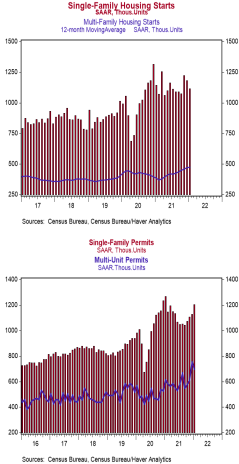- Housing starts declined 4.1% in January to a 1.638 million annual rate, lagging the consensus expected 1.695 million. Starts are up 0.8% versus a year ago.
- The drop in January was due to both single-family and multi-family starts. In the past year, single-family starts are down 2.4% while multi-unit starts are up 8.3%.
- Starts in January fell in the Midwest and South but rose in the West and the Northeast.
- New building permits increased 0.7% in January to a 1.899 million annual rate, beating the consensus expected 1.750 million. Compared to a year ago, permits for single-family units are down 5.0% while permits for multi-family homes are up 12.8%.
Implications:
After three months in a row of gains, new home construction started 2022 on a slightly softer note. There were two likely sources of weakness in January. First, following the warmest December since at least 1921 in the lower 48 states, the weather became unusually cold in January which probably slowed down activity in certain parts of the country. Second, January was the month when COVID cases were setting record highs due to the highly contagious Omicron variant. In fact, the US Census Bureau reports that 8.8 million workers called in sick in January, likely exacerbating the current labor shortages in the homebuilding industry. Looking at the details of the report, both single and multi-family construction posted declines. However, we expect a rebound in construction in the coming months as these temporary factors dissipate. Builders still have a huge number of permitted projects sitting in the pipeline waiting to be started. In fact, the backlog of projects that have been authorized but not yet started is currently the highest since the series began back in 1999. Meanwhile, permits for new building projects rose 0.7% in January as well, demonstrating that builders continue to see more demand on the horizon. With plenty of future building activity in the pipeline, builders looking to boost the near record-low levels of inventory to satisfy buyers, and as more Millennials finally enter the housing market, it looks very likely construction will continue its upward trend. Keep in mind the US needs roughly 1.5 million housing starts per year based on population growth and scrappage (voluntary knockdowns, natural disasters, etc.), and 2021 was the first year in the aftermath of the 2008/9 recession that has crossed that threshold. We currently expect 2022 to exceed that benchmark as well. In other recent housing news, the NAHB Housing Index, which measures homebuilder sentiment, declined slightly to 82 in February from 83 in January. However, these readings remain near historical highs, signaling robust optimism from developers. In employment news this morning, initial unemployment claims increased 23,000 last week to 248,000. Meanwhile, continuing claims fell 26,000 to 1.593 million. Finally, on the manufacturing front, the Philadelphia Fed Index, a measure of factory sentiment in that region, fell to a still elevated +16.0 in February from +23.2 in January.





